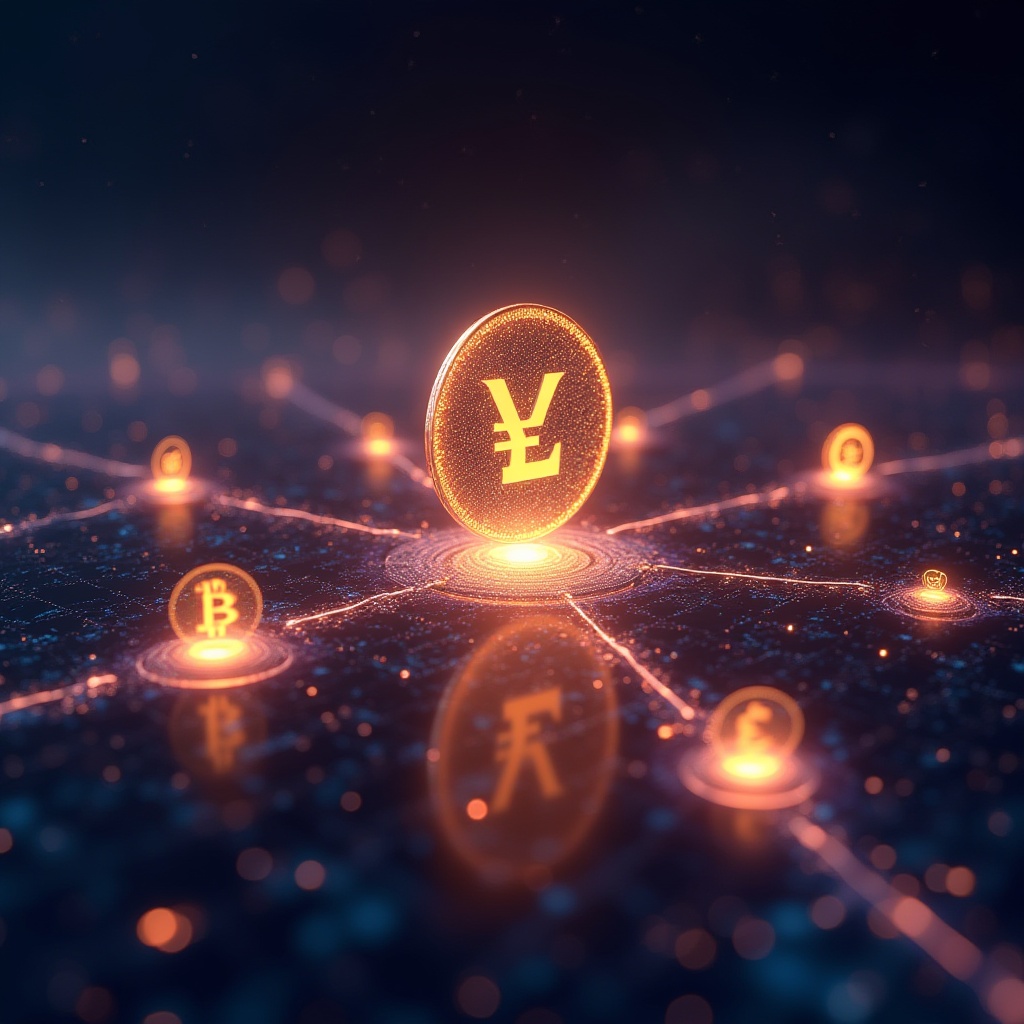In 2025, the crypto landscape is undergoing a significant transformation. The integration of Real-World Assets (RWAs) into blockchain ecosystems is no longer a theoretical concept but a tangible reality reshaping decentralized finance (DeFi). This evolution is driven by the tokenization of traditional assets—such as real estate, government bonds, and private credit—bringing them onto blockchain platforms. This process is not only enhancing liquidity but also attracting institutional investors seeking compliance, transparency, and yield.
As of June 2025, over $23 billion in RWAs are locked on-chain, marking a 5.78% increase from the previous month. This growth is indicative of a broader trend where RWAs are becoming a cornerstone of DeFi, offering more stable and regulated investment opportunities compared to traditional crypto assets.
The significance of this shift is underscored by major financial institutions embracing tokenization. For instance, BlackRock has launched its first tokenized fund on the Ethereum blockchain, allowing investors to earn yields on U.S. Treasury bills through digital tokens. Similarly, State Street has partnered with Swiss crypto firm Taurus to offer tokenized asset services, catering to the growing institutional demand for such investments.
The tokenization of RWAs is not just a trend but a fundamental shift in how assets are managed and traded. It bridges the gap between traditional finance and the digital asset world, offering enhanced efficiency, transparency, and accessibility. As we delve deeper into this topic, we’ll explore the evolution, current landscape, key players, benefits, challenges, and future prospects of RWA tokenization.
The Evolution of RWA Tokenization
The journey of real-world asset (RWA) tokenization is a testament to the convergence of traditional finance and blockchain technology. This evolution can be traced through several pivotal phases, each marked by technological advancements and shifts in financial paradigms.
Before the advent of blockchain, the financial industry had already begun exploring digital representations of real-world assets. In the 1990s, instruments like Real Estate Investment Trusts (REITs) and Exchange-Traded Funds (ETFs) emerged, allowing investors to gain exposure to real estate and commodities without direct ownership. These instruments digitized asset ownership but relied heavily on centralized intermediaries for management and settlement.
The introduction of Bitcoin in 2009 marked a significant shift, demonstrating the potential of decentralized ledgers for secure, peer-to-peer transactions. This innovation spurred interest in applying blockchain technology to a broader range of assets.
The launch of Ethereum in 2015 introduced smart contracts, programmable agreements that execute automatically when predefined conditions are met. This innovation provided a more versatile platform for asset tokenization. Projects like MakerDAO began leveraging Ethereum’s capabilities to create decentralized financial instruments.
As blockchain technology matured, institutional interest in RWA tokenization grew. Financial institutions recognized the potential for increased efficiency, transparency, and accessibility. For example, BlackRock launched its first tokenized fund on the Ethereum blockchain, offering investors exposure to U.S. Treasury bills through digital tokens. Similarly, State Street partnered with crypto firm Taurus to provide tokenized asset services.
Regulatory frameworks have also evolved to accommodate tokenized assets. Security Token Offerings (STOs) emerged as a compliant method for issuing digital securities, aligning with existing financial regulations.
Today, the tokenization of RWAs encompasses a diverse array of assets, including real estate, commodities, and private credit. Platforms like Centrifuge and Maple Finance facilitate the integration of these assets into DeFi ecosystems. As the infrastructure supporting RWA tokenization matures, we can anticipate increased accessibility, efficiency, and innovation in the financial sector.
Market Overview: RWA Tokenization in 2025
The tokenization of real-world assets (RWAs) has transitioned from a conceptual innovation to a substantial force within the decentralized finance (DeFi) ecosystem. As of June 2025, the Total Value Locked (TVL) in RWA projects has reached approximately $23.33 billion, marking a 5.78% increase over the past 30 days.
This growth is driven by several key factors. First, institutional adoption is accelerating. Major financial institutions are increasingly embracing RWA tokenization. BlackRock’s BUIDL fund, for instance, manages around $2.5 billion in tokenized U.S. Treasuries, representing a significant portion of the market.
Second, the range of tokenized assets has expanded beyond traditional financial instruments to include real estate, commodities, and private credit. This diversification attracts a broader investor base seeking exposure to various asset types.
Third, enhanced blockchain infrastructure and interoperability solutions have facilitated the seamless integration of RWAs into DeFi platforms, improving accessibility and efficiency.
The market capitalization of RWA tokens has experienced significant growth. As of May 2025, the RWA market stands at an estimated $22–25 billion, a substantial increase from $5 billion in 2023. Analysts project that the market could reach between $5 trillion and $16 trillion by 2030.
Platforms such as Ondo Finance, Centrifuge, Goldfinch, and Maple Finance exemplify the diverse approaches to RWA tokenization. Each contributes to the ecosystem’s growth and maturity through unique strategies and offerings. Understanding this current landscape is crucial for stakeholders aiming to navigate and capitalize on this transformative trend.
Leading RWA Tokenization Projects
The real-world asset (RWA) tokenization landscape in 2025 is defined by a few pioneering platforms that have successfully bridged traditional finance with decentralized finance. These platforms—Ondo Finance, Centrifuge, Goldfinch, and Maple Finance—have each carved out unique niches.
Ondo Finance has emerged as a leader in bringing traditional financial instruments, particularly U.S. Treasuries, onto the blockchain. Their flagship product, the Ondo Short-Term U.S. Government Treasuries (OUSG), provides exposure to short-term Treasuries and money market funds. Ondo also plans to deploy its fund on the XRP Ledger and collaborated with JPMorgan on a tokenized treasury trade using Chainlink.
Centrifuge offers a platform for tokenizing a range of real-world assets including invoices and real estate. Their infrastructure supports tokenization, management, and DeFi investment into RWAs. Centrifuge’s introduction of deRWA tokens enables existing securities to interact with DeFi, and their $400 million Treasury fund expansion to the Solana blockchain has drawn attention.
Goldfinch is a decentralized credit protocol that enables crypto borrowing without crypto collateral. It connects investors with businesses in emerging markets, offering stablecoin returns through real-world lending. This model is particularly impactful in regions like Africa and Southeast Asia.
Maple Finance provides uncollateralized loans for institutional borrowers. However, due to market volatility, it has shifted toward requiring overcollateralization. Still, it remains an important player offering transparent, blockchain-based institutional lending solutions.
These projects demonstrate how diverse strategies are helping shape and scale the RWA tokenization market.
Benefits of RWA Tokenization
Tokenizing real-world assets (RWAs) is transforming the financial landscape by integrating tangible assets into blockchain ecosystems. This integration enhances efficiency, accessibility, and transparency.
One major benefit is enhanced liquidity. Traditionally illiquid assets like real estate can be fractionalized and traded as digital tokens. This increases market participation and makes it easier to enter or exit positions.
Tokenization also increases accessibility. Investors can purchase fractional shares of high-value assets, lowering barriers to entry and broadening participation. This democratizes wealth creation and investment opportunities.
Operational efficiency improves as blockchain automates asset management functions using smart contracts. These reduce intermediaries, minimize human error, and enable faster settlements.
Transparency and security are inherent to blockchain. Every transaction is immutable and verifiable, reducing fraud and building trust. This is vital in sectors like real estate or supply chains where provenance is key.
Fractional ownership allows diversification across multiple assets with smaller capital outlays. Investors can spread risk and optimize returns more effectively.
Tokenization also unlocks global reach. It enables cross-border transactions without reliance on traditional banking infrastructure, expanding market access.
Lastly, programmability through smart contracts enables automated compliance, revenue sharing, and other financial processes, further enhancing utility.
Challenges and Considerations
Despite its advantages, RWA tokenization faces complex challenges. Legal and regulatory uncertainties remain a primary barrier. In many jurisdictions, digital tokens are not yet fully recognized as representations of legal ownership. This hinders enforceability and reduces institutional confidence.
Custodial and technical risks also pose threats. Smart contract vulnerabilities or poor custody solutions could result in asset mismanagement or theft. Robust security protocols and third-party verifications are critical.
Market liquidity is another concern. Tokenization doesn’t guarantee demand. Without active secondary markets and investor engagement, tokens may remain illiquid.
Interoperability is limited by blockchain fragmentation. Many platforms use different standards, making it difficult to transfer assets across networks. Common frameworks are necessary to improve ecosystem efficiency.
Investor education is lacking. RWA tokenization is complex, and a lack of understanding can hinder adoption. Clear communication and education initiatives are essential to build trust and informed participation.
Addressing these challenges is vital for sustainable growth and institutional involvement in RWA markets.
The Future of RWA Tokenization
The future of RWA tokenization is rich with promise. Market forecasts suggest a rise from current levels of around $50 billion to over $500 billion by year-end. Long-term estimates range between $5 trillion and $16 trillion by 2030.
Technological advancements are central to this growth. Layer 2 solutions, zero-knowledge proofs, and interoperability protocols are enhancing scalability, privacy, and cross-chain integration. These innovations make RWA tokenization more practical and secure.
Asset classes are also expanding. In addition to real estate and treasuries, projects are exploring carbon credits, human capital, and intellectual property. This diversification increases relevance and market appeal.
Traditional finance is integrating blockchain technology. Central bank digital currencies and hybrid models are bringing DeFi principles into the mainstream. Financial institutions are combining regulated finance with tokenization strategies.
Geographically, adoption is accelerating. Asia and Africa are emerging as hubs for experimentation and implementation. Regional innovations are helping drive global best practices.
The convergence of RWAs and the metaverse is also opening new markets. Tokenized virtual real estate and digital collectibles linked to physical items are creating new value models.
The RWA sector is poised for exponential growth, driven by tech, regulation, and market demand.
From Buzzword to Billions
In 2025, the tokenization of real-world assets (RWAs) has evolved from a buzzword to a dominant trend in global finance. With over $50 billion in on-chain assets, tokenization is fundamentally altering how assets are owned, managed, and traded.
By enabling fractional ownership and instant settlement, tokenized assets enhance liquidity, accessibility, and transparency. They make investing more democratic and efficient, breaking down barriers that once limited market participation.
Institutional adoption is accelerating. Firms like BlackRock and State Street are actively engaging with tokenized treasuries and securities, validating the technology’s credibility.
At the same time, challenges around regulation, custody, and infrastructure remain. But the trajectory is clear: RWA tokenization is not a passing phase. It is a foundational shift toward a more inclusive and programmable financial system.
The fusion of real-world value with blockchain transparency offers a future where finance is open, accessible, and resilient. That future is not years away—it is being built now.





